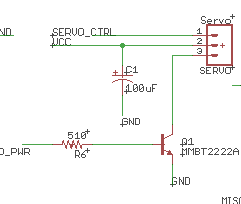I have 3 D cell alkaline batteries in series. They are rated at 20Ah. https://uk.rs-online.com/web/p/d-batteries/9145058/
The circuit spend most of its time in deep sleep only consuming 8 uA of current. Whilst active, it has the following current demands:
- Between 40mA to 60mA for RF module.
- Roughly 50mA for the MCU and other sensors.
- Between 300mA to possibly upto 1A for servo, which only drives the load from 0-180 for 10 times during 24h.
In case you guys wondering why use such heavy duty batteries, the aim of the product is to last 3 -5 years on batteries.
In my design what I have done so far is, I have used a 250mA LDO to power the MCU and other circuit whilst I supplied the servo power directly from the battery, whilst servo PWM control is coming from the MCU. https://uk.rs-online.com/web/p/low-dropout-voltage-regulators/6694897/
My servo circuit is shown. I have 100uF to account for peak current surges. My servo is SG90 https://www.rapidonline.com/rvfm-tower-pro-sg90-mini-servo-37-1330.
Now my circuit works fine for most of the time, but sometimes servo fails to operate the load. I have a couple of choices here.
- I could increase the capacitor from 100uF to possibly 1F cap.
- Use a boost for the voltage supply for the servo because I am mindful the 3 x 1.5V alkaline batteries in series are 4.5V. Boosting the servo voltage to 6V might be good way forward.


